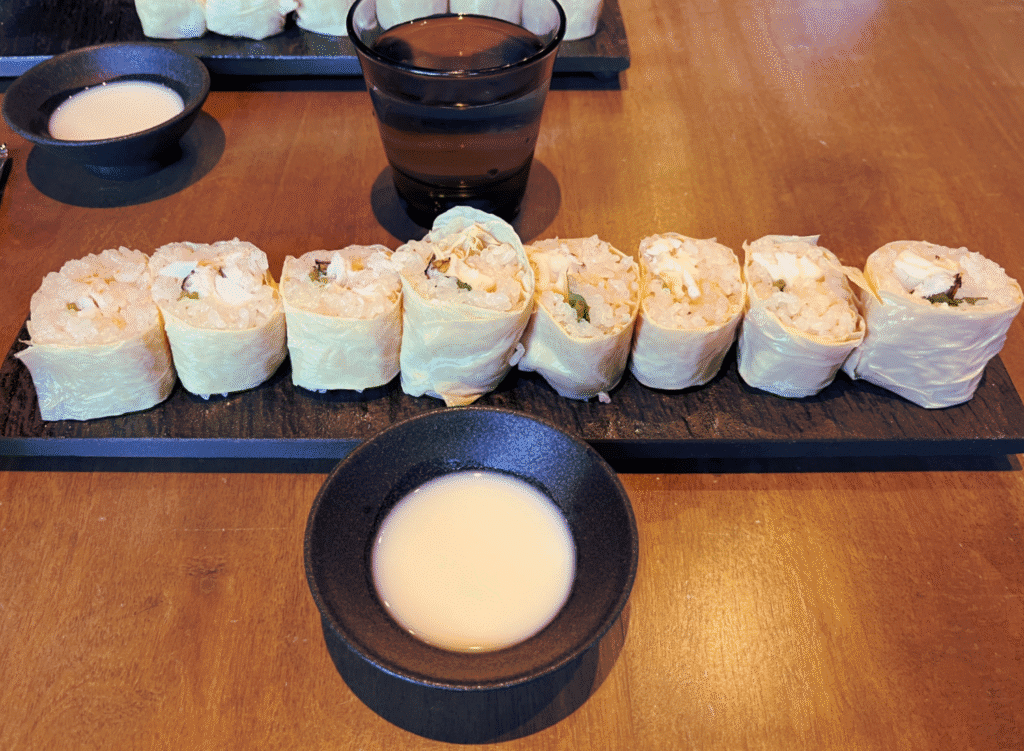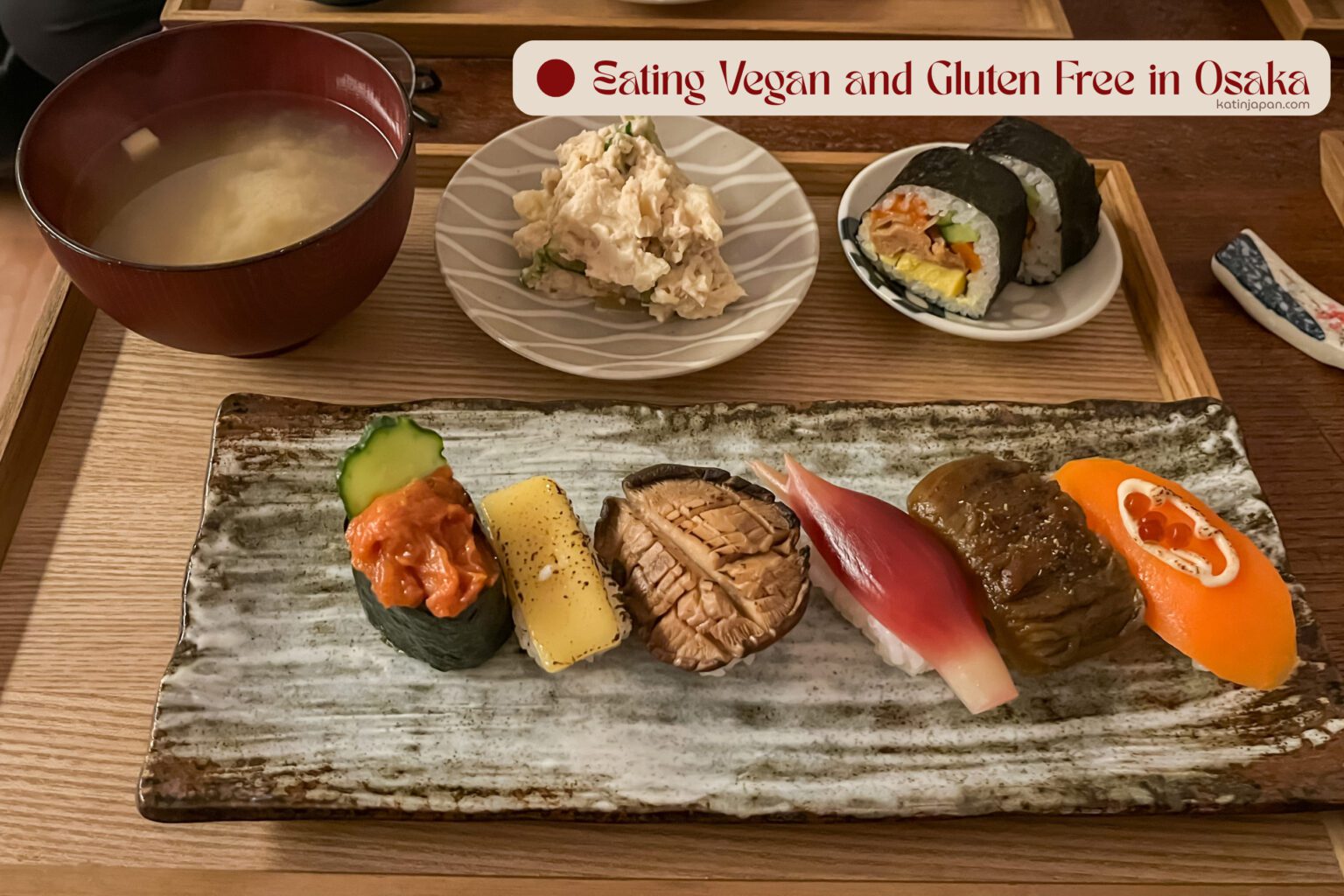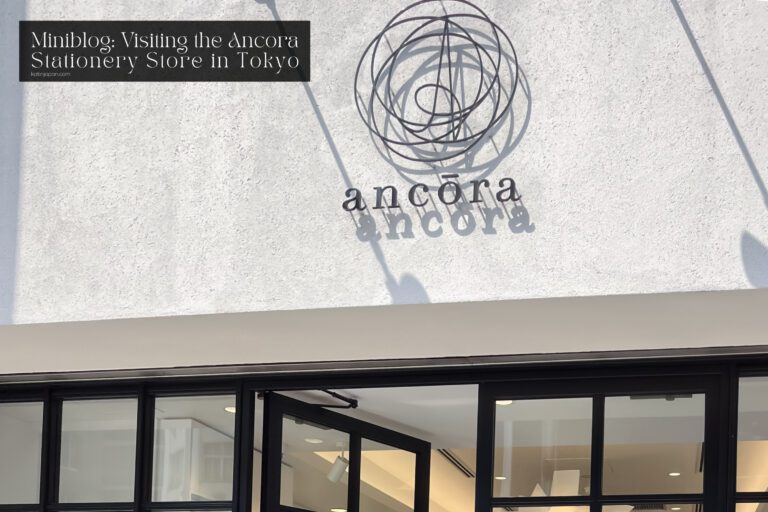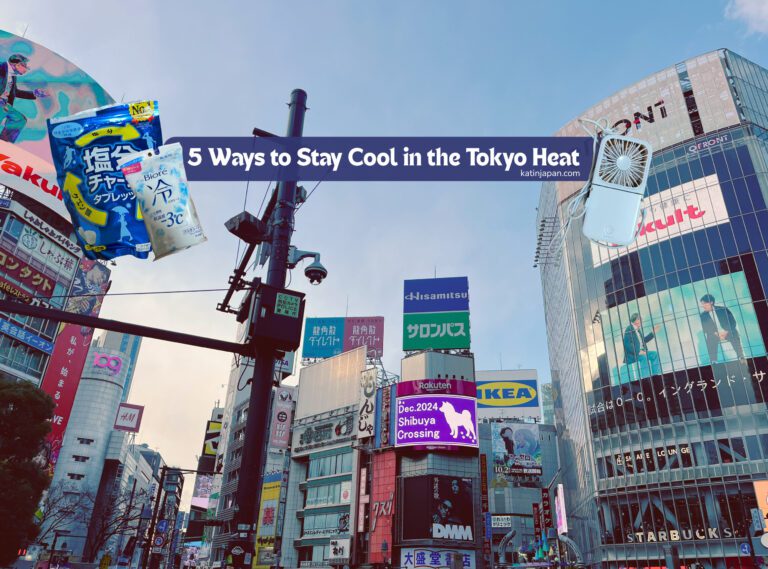Eating vegan and gluten-free can be a challenge anywhere you go, but we found some delicious gluten-free options during our visit to Osaka.
In March this year, some of Ramón’s family visited from California. We had a great time exploring areas throughout Japan, from Nikko Toshogu, to the Gundam in Tokyo, and Tsutenkaku in Osaka.
His father and sister-in-law are both vegan, and she’s gluten-free. So we visited many restaurants that could prepare gluten-free meals. We also did our best to cook meals along the way.
While there were limitations, I was genuinely surprised by the GF options available in many restaurants and convenience stores.
So read on to learn about our foray into eating vegan and gluten-free in Osaka.
Disclaimer: I don’t personally have celiac disease or a gluten sensitivity. Take your own precautions when researching GF options.

I won’t sugarcoat things. Eating vegan and gluten-free in Japan can be particularly difficult.
Though 5-10% of infants in Japan are said to have food allergies, and therefore many children and adults also do, asking for accommodations in restaurants isn’t common.
Also, while foods like eggs, milk, and wheat are well-known allergens, diets like vegetarianism and veganism are not widespread.
Many Japanese dishes also utilize animal products where you least expect it. For example: butter, anchovy dashi, pork or chicken broth, and gelatin.
Allergens Don’t Have to be Disclosed at Restaurants
Another major reason for low food accommodation is that food allergies are not required to be disclosed in restaurants due to differing business practices, facilities, sizes, etc.
While common allergies in Japan like soba, eggs, and fish are well-known, vegetarian, vegan, and gluten-free diets still aren’t well understood. Therefore many restaurants will not have alternatives ready.
Restaurants in Japan have only recently improved at dealing with food allergies, especially family restaurant chains. Still, at many restaurants, chefs and staff do not accommodate for all food allergies.
BoutiqueJapan states this well. People are less accustomed to asking for dietary accommodations, and some considerations are not common in Japan.
I personally think this is partially due to the idea of “omakase”, which leaves the menu up to the chef. Some chefs are professional craftsmen, and food is their art. So, making changes to the menu can be uncomfortable or impossible.
Awareness of special diets is improving, but could be so much better.
But Allergens are Disclosed on Processed Foods!

Allergens are indeed required to be stated on processed foods such as snacks, bento boxes, and other packaged foods.
However, this doesn’t cover everything at the store. Not to mention, these disclosures are often in Japanese.
Also, not all allergens are required – only the 8 most common.
Allergens Disclosed on Products
According to the Consumer Affairs Agency, these are the required labels for food allergens.
The eight required food allergens are:
Shrimp, Crab, Peanuts, Eggs, Walnuts, Wheat, Soba, and Milk.
Recommended labels (not required to be stated):
Almonds, Abalone, Squid, Cashews, Oranges, Kiwis, Bananas, Ikura (salmon roe), Beef, Sesame, Salmon, Soybeans, Mackerel, Chicken, Pork, Macadamia nuts, Peaches, Yamaimo (Japanese mountain yam), Gelatin, and Apples.
It’s Possible to Eat Vegan and Gluten-Free in Japan
Luckily, these days, it’s not impossible to eat vegan and gluten-free. It’ll just take some extra thought and preparation.
For example, we booked Airbnb’s with kitchen facilities so we could cook if needed. We also utilized the website/app Find Me Gluten-Free to find well-reviewed restaurants that were either gluten-free or could handle making amendments to their menu.
I also recommend you carry a laminated gluten-free/allergy card. If you tell a restaurant you have allergies, they will take this seriously and try to help where possible.
Sometimes you have to know what the biggest gluten-containing ingredients in Japan are to avoid them. Soy sauce, dashi, and miso are some of the main culprits.
You can use this script to ask restaurants if they can accommodate you. Whether you try to say it in Japanese or print it on a card is up to you.
But when in doubt, you can use existing allergy cards by trustworthy sources. Disclaimer: Use this at your own risk.
すみません、アレルギがあります。小麦が入っている食べ物は食べられません。それは対応できますか。小麦粉、醤油、や小麦粉を含まれる味噌、出汁、などがダメです。
Sumimasen, arerugi ga arimasu. komugi ga haitteiru tabemono wa taberaremasen. Sore wa taiou dekimasuka? Komugiko, shoyu, ya komugiko wo fukumareru miso, dashi, nado ga dame desu.
Excuse me, I have an allergy. I cannot eat foods with wheat. Can you accommodate this? Foods like wheat and soysauce, or miso, dashi, etc. containing wheat are a no-go.
Jodi at Legalnomads has an excellent article on how to navigate eating GF in Japan, with some very in-depth information and allergy cards.
She also talks about booking ryokans or restaurants ahead of time to notify them about her dietary restrictions. This is a great strategy for experiencing Japanese tradition while staying healthy.
In our experience, a surprising number of restaurant staff knew that there is wheat in soy sauce and some miso products. If you can speak Japanese or have a tour guide, navigating this should be easier, but otherwise, having an allergy card will help a lot.
Our Experience Eating Vegan and Gluten-Free in Osaka
In March, we met up with Ramon’s dad, brother, and sister-in-law.
The trip covered Utsunomiya, Nikko, Tokyo, and Osaka. However, we spent the most time in Tokyo and Osaka.
The trip was fantastic, but we had to be aware of restaurants that could accommodate vegan and gluten-free diets.
And truthfully, most were vegan or vegetarian first, gluten-free second.
I was pleasantly surprised at how many restaurants could accommodate our group.

Convenience Stores

When it comes to convenience stores, options are limited. However, you can find foods like plain riceballs, Soyjoy protein bars, and others if you know where to look.
They also usually stock salads and vegetables, with separate dressing packets.
We also found soymilk, almond milk, and sometimes even oat milk in the refrigerated section.
You can also get dried fruits, nuts, chips, and drinks that don’t contain animal products or gluten.
They take extra effort to find, but it is possible.
Grocery Stores
One of the nice things about Japanese supermarkets is that they usually have a great array of fresh vegetables, mushrooms, tofu, etc.
You can even find fake meat, though you have to check it for wheat. Nowadays, stores also sell beans both in the salad and canned goods sections. Just try to get them unsweetened.
Red beans and lima beans tend to be sold sweetened. Soybeans, “salad beans”, and chickpeas are a good bet for savory applications.
Fruit is a bit pricey, but usually they have a fresh selection of seasonal fruits.
Some stores in Tokyo are pitifully small, so try to find big centers like Aeon, Ito Yokado, or Summit. Central Tokyo has some large grocery stores, but we had better luck in Osaka.
It was difficult to find tamari as a substitute for soy sauce in stores, though. Instead, we used salt and lots of spices.
There was miso that didn’t have wheat included, but most premade sauces and spice packets come with a gluten risk, so we skipped those.
Restaurants

We found a surprising number of places to eat vegan and gluten-free in Osaka. In retrospect, it makes sense.
Osaka is often called Japan’s food capital. From okonomiyaki to yakiniku, it’s the place to go for food tourism.
When using the Find Me Gluten-Free app, what we found was that most places weren’t necessarily gluten-free. However, most vegan restaurants could accommodate us.
You may need to ask restaurants upfront about their ability to accommodate your dietary needs. However, most restaurants we visited were happy to adjust their menu items with a heads-up.
For example, Yubamaki ZEN in Nikko was able to remove the soy sauce and marinated black beans from the roll we ordered.
Keep in mind that while these restaurants were able to accommodate vegan and gluten-free diets, some had to be asked specifically to remove certain ingredients. Also, some couldn’t be confirmed as having no cross-contamination.
Vegan and Gluten-Free Restaurants in Osaka

We tried vegan sushi, and I was genuinely delighted by it.
Shojin Sushi Minamo is a vegan, gluten-free sushi spot near America-Mura in Osaka. “Shōjin” refers to traditional Buddhist vegetarian cooking. It’s a good term to look for when researching vegan and vegetarian restaurants. Not all shōjin food is GF, though.
We got hungry around 11 am, so when we found Minamo online, I made a reservation. If you have a Japanese phone number, you can make an account with sites like Gurunavi and Hotpepper, which are popular for restaurant reservations.
And if not, some hotels will let you use their phone number, it seems. Just let the front desk know ahead of time.
Making the same-day reservation was great because it meant we weren’t waiting when they opened. We got a seat tucked away in a small alcove.

Using some blend of magic and practical cooking techniques, they convinced me that vegan sushi can be delicious.
Minamo used meticulously prepared vegetables to bring out the flavor of each food.
The carrot marinated to taste like salmon and faux ikura passed as fish. The eggplant had a charred flavor that tasted exactly like beef to me. It was all surprising and wonderful.
They also used tiny tofu cubes in the miso soup that I think were either freeze-dried or deep-fried, as their texture was surprisingly firm.
These tofu cubes were also used in the potato salad and had the exact texture of meat. This mimicked the ham that often comes in Japanese potato salad, which usually contains cucumbers and carrots, too.
While the myōga (Japanese ginger), shiitake, tomato, and “cheese” nigiri didn’t try to masquerade as fish, their own unique flavors shone through. And that’s really the heart of sushi.
When we left, a line was already forming. Minamo seemed popular as one of the few vegan sushi restaurants in town.
My Ranking: ⭐️⭐️⭐️⭐️⭐️
Saijiki is a vegetarian restaurant serving up Taiwanese dishes, many of which are also vegan.
They had a variety of options, and we ordered their mapo tofu, sautéed greens, faux fish stir-fry, braised “meat” stir-fry, a vegan ground “meat” rice bowl, and bao.
I was particularly happy with their mapo tofu. It was perfectly Szechuan spicy, without blowing my head off with spice. The vegan ground “meat” stir-fry with rice, and bao buns got some good reviews from my husband and brother-in-law.
I will say the floor and surfaces were a bit sticky for my liking, but the chefs were accommodating. They prepared the dishes we requested without wheat and soy sauce.
My Ranking: ⭐️⭐️⭐️


Oko actually has two locations. One for Takoyaki, and one for Okonomiyaki. It was absolutely worth the wait, and the portion was commensurate with the price.
The gluten-free okonomiyaki is made with okara (おから), a soy byproduct usually used in things like soy milk hotpot (豆乳鍋 tōnyu nabe).
Apparently, the original restaurant was so popular that they had to reopen in a larger building. The new location:
Unfortunately, only one person works both the counter and the kitchen, so the wait was long. Like… an hour long. But we knew that going in, so I can’t really complain. And this is the only vegan, GF okonomiyaki we could find.
The atmosphere was eccentric. There were paint pens along the walls and messages across the entire space. Old-timey American-style music was playing the whole time.
And when you make a drink at the make-it-yourself cocktail bar, you squeeze the chicken to let the cook know. It was a really unique experience.
They serve both gluten-free and non GF okonomiyaki. The portions were insanely filling, and you could choose your ingredients.
Just keep an ear out for your order. The seating was on the top floor, where a speaker would call out the number.
We tried the GF gyoza and okonomiyaki, and both got rave reviews from our guests.
My Ranking: ⭐️⭐️⭐️⭐️
This cozy little cafe near Osaka Castle had lots of gluten-free treats like cookies and cakes.
They also served up egg salad sandwich sets for lunch. The price wasn’t too bad, but it did take some time for them to prepare the sets.
The indoor seating was also limited, so we opted to take the food to go.
My Ranking: ⭐️⭐️⭐️
Vegan and Gluten-Free Restaurants in Tokyo


Alchemy is located on the 4th floor of the Azabudai Hills Tower Plaza mall. It’s a ritzy place, reminding me of high-end spots in Los Angeles.
There were so many people chatting, walking their dogs, and having a relaxing time amongst all the luxury shops.
We met up with a friend to have lunch and chat. Since it wasn’t busy during the afternoon, we were able to relax for a long time.
Alchemy’s main offering is vegan bowls. They also have salads, desserts, and sandwiches. We checked with our server to verify that they have gluten-free meals just in case. They even had a gluten-free “pizza” our friend tried.
It also featured a bulk stand where you could buy beans, lentils, etc., and other offerings like specialty sodas. The bowls were tasty, and a decent portion, if a little pricey.
My Ranking: ⭐️⭐️⭐️
We tried the Gluten-Free T’s Kitchen in Ueno before catching our Shinkansen. They had good-tasting food, albeit at a higher price.
It’s attached to an APA hotel, and its seating is limited. Because we were in a rush, the atmosphere felt quite claustrophobic, but the clerk tried to be helpful.
You order with your phone, so it’s in English. However, it took a while to receive our orders.
My Ranking: ⭐️⭐️
Vegan and Gluten-Free Restaurant in Utsunomiya

Located in Utsunomiya, Levon Helm serves up vegan “natural food”, doing their best to limit toxins.
According to their website, they use only stainless steel cookware and organic, pesticide-free ingredients.
Ramón ordered the western meal (yōzen 洋膳) which came with an appetizer round and a pasta. The waiters were very helpful when asked about gluten-free options and were able to accommodate us.
My Ranking: ⭐️⭐️⭐️⭐️
Vegan and Gluten-Free Restaurant in Nikko


ZEN is a “yubamaki” aka yuba roll restaurant. Yuba is another shōjin ryōri staple, made from skimming the surface of boiling soy milk used to create tofu.
Since yuba was traditionally used as a staple in buddhist monk dishes, its origin is already vegan. And Nikko is famous for it.
There are many shops in the main town that serve it. However, the staff at ZEN was very helpful when we requested gluten-free dishes.
It had an upscale atmosphere, and there were some large tables in the front, and more seating in the back of the restaurant. You order with your smartphone using a QR code, but you can talk directly with a server before ordering to confirm your allergies.
The server was very knowledgeable about removing the soy sauce and beans braised in soy sauce from the rolls. She was very personable and helped us out.
For more tips on what to do in Nikko, check out my Top 7 Things to do in Nikko and Kinugawa.
My Ranking: ⭐️⭐️⭐️⭐️
Final Thoughts and Considerations

Overall, I was worried about whether we would find places to eat, but I was pleasantly surprised by both the selection of places and the willingness to accommodate.
If you do a little pre-work and plan your route, you should be able to find safe and delicious food.
However, if you go to the countryside or away from city centers, be prepared ahead of time.
While cities tend to be more cosmopolitan, the countryside has fewer options. I recommend bringing snacks, especially ones from your own country. Alternatively, you can bring snacks you’ve found at convenience or grocery stores.
Also, having someone who can speak Japanese or a good allergy card is a must. If you’re able to book restaurants ahead of time and notify them of your allergies, this can be extremely helpful.
Overall, eating vegan and gluten-free in Osaka and the other destinations on our trip was easier and more flavorful than I expected.




